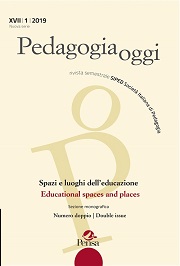Spaces of flow: rethinking educational places in the work with adolescents
Abstract
The trajectories of contemporary adolescents appear to tend towards phenomena of transience and “dispersal”, a state of constant movement and flux, which are difficult to relate to significant places of identity and belonging. Teenagers’ use of educational places, both formal and informal, across the urban territory, is increasingly characterized by a metropolitan “nomadism” that expresses their need for continuous movement and short timespans. Groups are no longer fixed in one place or reliant on local recognition but display fluid modes of belonging and identification. The paths followed by adolescents in the early twenty-first century are extraordinarily similar to the social networking model. Groups develop around attractive features that “emerge” from the territory, serving as focal points for the production of “fleeting” experiences, which are characterized as events-based forms of entertainment that are temporary and transitory in nature. This leads us to interpret the specific ways in which adolescents move through the territorial spaces of their city and inhabit its timeframes, as an effect of a complex
dispositive that at the urban level contributes to producing a consumption-oriented subjectivity.




